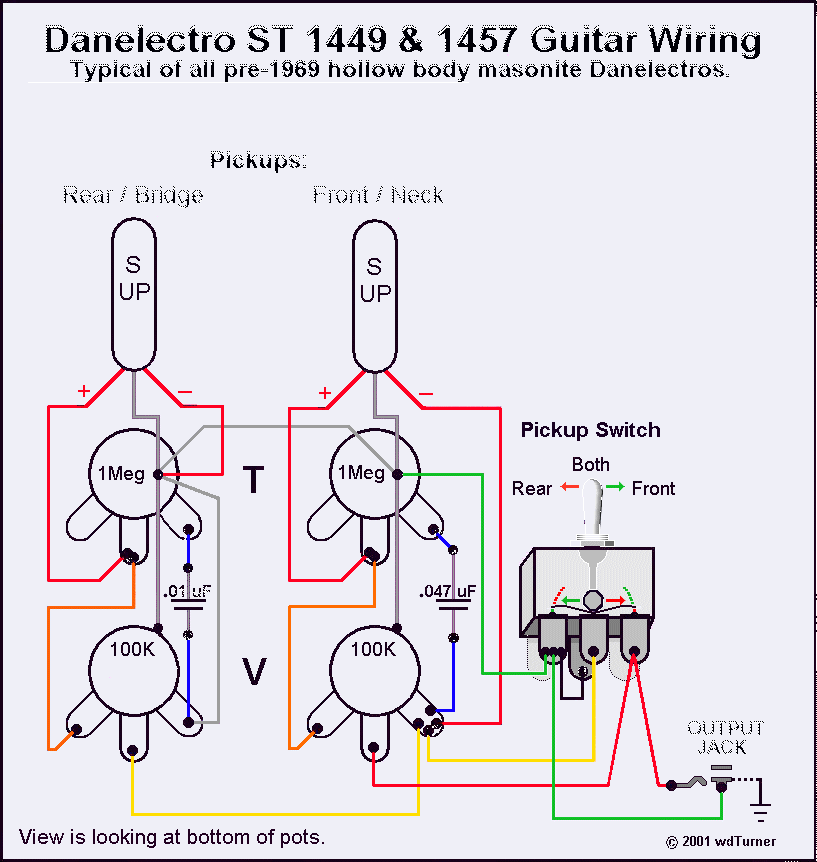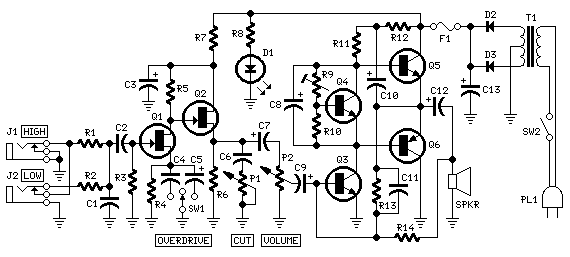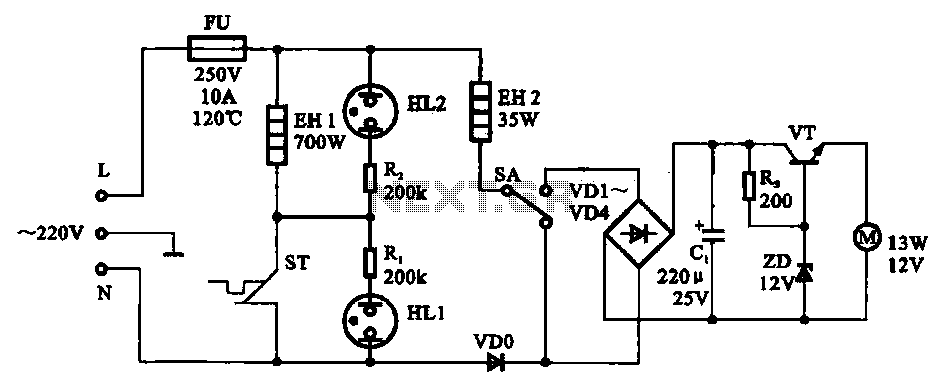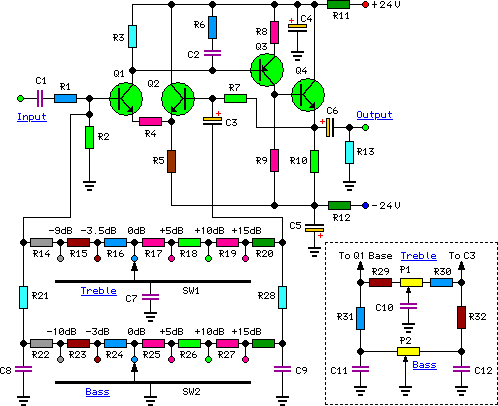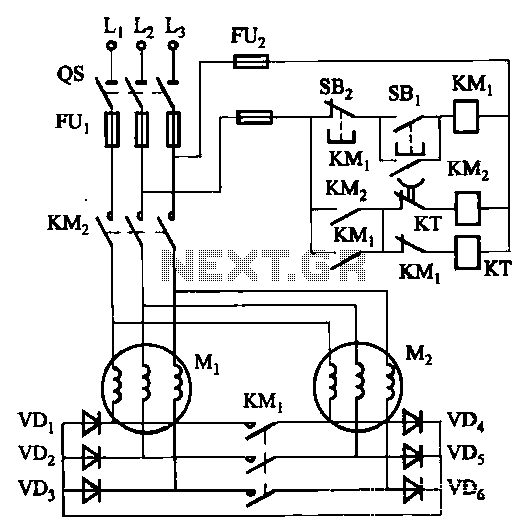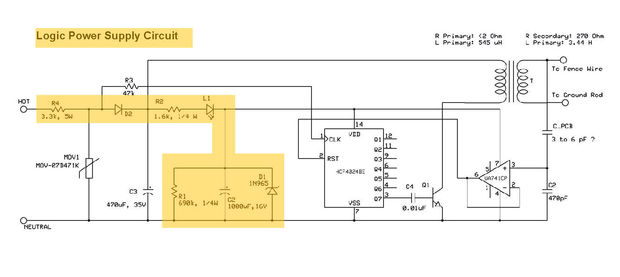
Electric Guitar Preamplifier
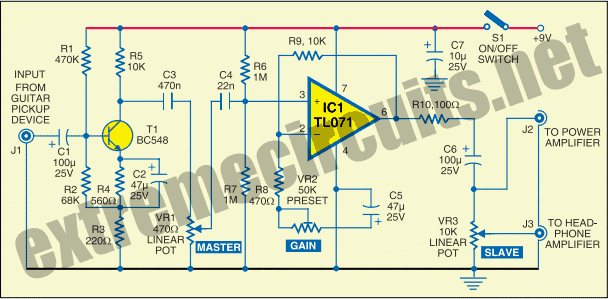
The circuit diagram of a guitar preamplifier is designed to accept any standard guitar pickup and features two signal outputs. A typical example of a pickup attached to a guitar headstock is illustrated. The pickup device consists of a transducer at one end and a jack at the other, which connects to a preamplifier circuit and subsequently to a power amplifier system. The pickup captures mechanical vibrations from stringed instruments, such as guitars or violins, converting them into electrical signals for amplification. It is typically mounted on the instrument's body but can also be attached to the bridge, neck, pick-guard, or headstock. The preamplifier circuit includes a single-transistor common-emitter amplifier with degenerative feedback in the emitter and a boot-strapped bias divider to ensure optimal input impedance. With the specified component values, the input impedance exceeds 50 kilo-ohms, and the peak output voltage is approximately 2V RMS. The master-level-control potentiometer VR1 should be adjusted to minimize distortion. The guitar pickup input is connected to the preamplifier at terminal J1, where the signal is buffered and processed by an op-amp circuit based on IC TL071 (IC1). The gain can be set using the preset VR2. The circuit includes both master and slave controls, with RCA socket J2 serving as the master signal output and socket J3 as the slave. It is recommended to use the signal from J2 as the input to the power amplifier system or sound mixer, while output signals from J3 can drive a standard headphone amplifier. The slave output signal level at J3 is adjustable using potentiometer VR3. The circuit should be housed in a metallic case, and VR1 and VR3 are preferably metal-enclosed types. To mitigate hum, it is essential to ground the case and enclosures. A well-regulated 9V DC power supply is necessary for this circuit, although a standard 9V alkaline manganese battery can also be utilized. Switch S1 functions as the power on/off switch.
The guitar preamplifier circuit serves as a crucial interface between passive guitar pickups and active amplification systems, ensuring that the delicate signal from the instrument is preserved and enhanced. The choice of a common-emitter amplifier configuration allows for a significant voltage gain while maintaining a high input impedance, which is essential for interfacing with high-impedance pickups. The degenerative feedback implemented in the emitter helps to stabilize the gain and reduce distortion, providing a cleaner output signal.
The use of the TL071 op-amp is particularly advantageous due to its low noise characteristics and high input impedance, making it suitable for audio applications. The gain adjustment via VR2 allows for flexibility in tailoring the output level to match the requirements of different amplifiers or mixers. The inclusion of both master and slave outputs enhances the circuit's versatility, allowing simultaneous connection to multiple devices without signal degradation.
Grounding the metallic enclosure is a critical step in minimizing electromagnetic interference and ensuring optimal performance. The design's power supply requirements highlight the importance of stable voltage levels in audio circuits, as fluctuations can lead to undesirable noise and distortion. The option to use a battery provides portability, making this preamplifier suitable for live performances where access to mains power may be limited.
Overall, this guitar preamplifier circuit is an effective solution for musicians seeking to achieve high-quality sound reproduction from their instruments, with considerations for both performance and practicality.Here is the circuit diagram of a guitar preamplifier that would accept any standard guitar pickup. It is also versatile in that it has two signal outputs. A typical example of using a pick-up attached to a guitar headstock is shown in Fig. 1. The pickup device has a transducer on one end and a jack on the other end. The jack can be plugged into a preamplifier circuit and then to a power amplifier system. The pickup device captures mechanical vibrations, usually from stringed instruments such as guitar or violin, and converts them into an electrical signal, which can then be amplified by an audio amplifier. It is most often mounted on the body of the instrument, but can also be attached to the bridge, neck, pick-guard or headstock.
The first part of this preamplifier circuit shown in Fig. 2 is a single-transistor common-emitter amplifier with degenerative feedback in the emitter and a boot-strapped bias divider to secure optimal input impedance. With the component values shown here, the input impedance is above 50 kilo-ohms and the peak output voltage is about 2V RMS.
Master-level-control potentiometer VR1 should be adjusted for minimal distortion. The input from guitar pickup is fed to this preamplifier at J1 terminal. The signal is buffered and processed by the op-amp circuit wired around IC TL071 (IC1). Set the gain using preset VR2. The circuit has a master and a slave control. RCA socket J2 is the master signal output socket and socket J3 is the slave. It is much better to take the signal from J2 as the input to the power amplifier system or sound mixer. Output signals from J3 can be used to drive a standard headphone amplifier. Using potentiometer VR3, set the slave output signal level at J3. House the circuit in a metallic case. VR1 and VR3 should preferably be the types with metal enclosures. To prevent hum, ground the case and the enclosures. A well-regulated 9V DC power supply is crucial for this circuit. However, a standard 9V alkaline manganese battery can also be used to power the circuit. Switch S1 is a power on/off switch. 🔗 External reference
The guitar preamplifier circuit serves as a crucial interface between passive guitar pickups and active amplification systems, ensuring that the delicate signal from the instrument is preserved and enhanced. The choice of a common-emitter amplifier configuration allows for a significant voltage gain while maintaining a high input impedance, which is essential for interfacing with high-impedance pickups. The degenerative feedback implemented in the emitter helps to stabilize the gain and reduce distortion, providing a cleaner output signal.
The use of the TL071 op-amp is particularly advantageous due to its low noise characteristics and high input impedance, making it suitable for audio applications. The gain adjustment via VR2 allows for flexibility in tailoring the output level to match the requirements of different amplifiers or mixers. The inclusion of both master and slave outputs enhances the circuit's versatility, allowing simultaneous connection to multiple devices without signal degradation.
Grounding the metallic enclosure is a critical step in minimizing electromagnetic interference and ensuring optimal performance. The design's power supply requirements highlight the importance of stable voltage levels in audio circuits, as fluctuations can lead to undesirable noise and distortion. The option to use a battery provides portability, making this preamplifier suitable for live performances where access to mains power may be limited.
Overall, this guitar preamplifier circuit is an effective solution for musicians seeking to achieve high-quality sound reproduction from their instruments, with considerations for both performance and practicality.Here is the circuit diagram of a guitar preamplifier that would accept any standard guitar pickup. It is also versatile in that it has two signal outputs. A typical example of using a pick-up attached to a guitar headstock is shown in Fig. 1. The pickup device has a transducer on one end and a jack on the other end. The jack can be plugged into a preamplifier circuit and then to a power amplifier system. The pickup device captures mechanical vibrations, usually from stringed instruments such as guitar or violin, and converts them into an electrical signal, which can then be amplified by an audio amplifier. It is most often mounted on the body of the instrument, but can also be attached to the bridge, neck, pick-guard or headstock.
The first part of this preamplifier circuit shown in Fig. 2 is a single-transistor common-emitter amplifier with degenerative feedback in the emitter and a boot-strapped bias divider to secure optimal input impedance. With the component values shown here, the input impedance is above 50 kilo-ohms and the peak output voltage is about 2V RMS.
Master-level-control potentiometer VR1 should be adjusted for minimal distortion. The input from guitar pickup is fed to this preamplifier at J1 terminal. The signal is buffered and processed by the op-amp circuit wired around IC TL071 (IC1). Set the gain using preset VR2. The circuit has a master and a slave control. RCA socket J2 is the master signal output socket and socket J3 is the slave. It is much better to take the signal from J2 as the input to the power amplifier system or sound mixer. Output signals from J3 can be used to drive a standard headphone amplifier. Using potentiometer VR3, set the slave output signal level at J3. House the circuit in a metallic case. VR1 and VR3 should preferably be the types with metal enclosures. To prevent hum, ground the case and the enclosures. A well-regulated 9V DC power supply is crucial for this circuit. However, a standard 9V alkaline manganese battery can also be used to power the circuit. Switch S1 is a power on/off switch. 🔗 External reference
